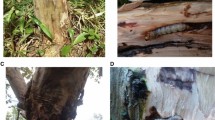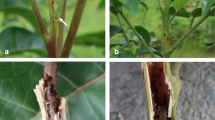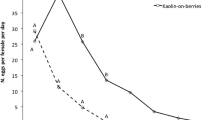Abstract
Stemphylium vesicarium, the causal agent of brown spot of pear, overwinters in the leaf residues of pear and herbaceous plants of the orchard floor. Pseudothecia of the teleomorph, Pleospora allii, are formed on these residues where they produce ascospores. New methods were tested aimed at reducing this overwintering inoculum and increasing the efficacy of control of brown spot of pear. Sanitation methods were evaluated in nine trials in Girona (Spain) and Ferrara (Italy) over a 4-year period. The sanitation methods were leaf litter removal in December to February, and application of biological control agents (commercial formulates of Trichoderma spp.) to the orchard ground cover from February to May. Fungicides were also applied to the trees during the pear-growing season, scheduled according to the BSPcast model. The different methods were tested as stand-alone applications or in combination. All methods consistently reduced the disease incidence at harvest on fruit with an efficacy between 30 to 60% for leaf litter removal and more than 60% for the combination of leaf litter removal and biological control. Efficacy of sanitation alone (leaf litter removal and biological control) in reducing the brown spot level on fruit was similar in most of the trials to the efficacy obtained when fungicides were applied alone. However, integration of sanitation methods and fungicides did not improve the efficacy of disease control over the level provided by fungicides alone.



Similar content being viewed by others
Abbreviations
- LLR:
-
Leaf litter removal
- BCA:
-
Biological control agent
- FUN:
-
Fungicides
References
Alberoni, G., Collina, M., Pancaldi, D., & Brunelli, A. (2005). Resistance to dicarboximide fungicides in Stemphylium vesicarium of Italian pear orchards. European Journal of Plant Pathology, 113, 211–219.
Aylor, D. E., & Kiyomoto, R. K. (1993). Relationship between aerial concentration of Venturia inaequalis ascospores and development of apple scab. Agricultural and Forest Meteorology, 63, 133–147.
Blancard, D., Allard, E., & Brest, P. (1989). La Stemphyliose du poirier ou “macules brunes”. Phytoma, 406, 35–37.
Campbell, C. L., & Madden, L. V. (1990). Introduction to plant disease epidemiology. New York: Wiley.
Carisse, O., & Rolland, D. (2004). Effect of timing of application of the biological control agent Microsphaeropsis ochracea on the production and ejection pattern of ascospores by Venturia inaequalis. Phytopathology, 94, 1305–1314.
Carisse, O., Philion, V., Rolland, D., & Bernier, J. (2000). Effect of fall application of fungal antagonists on spring ascospore production of the apple scab pathogen, Venturia inaequalis. Phytopathology, 90, 31–37.
Duthie, J. A., & Campbell, C. L. (1991). Effects of plant debris on intensity of leaf spot diseases, incidence of pathogens, and growth of alfalfa. Phytopathology, 81, 511–517.
Faize, M., Malnoy, M., Dupuis, F., Chevalier, M., Parisi, L., & Chevreau, E. (2003). Chitinases of Trichoderma atroviride induce scab resistance and some metabolic changes in two cultivars of apple. Phytopathology, 93, 1496–1504.
Gadoury, D. M., & MacHardy, W. E. (1986). Forecasting ascospore dose of Venturia inaequalis in commercial apple orchards. Phytopathology, 76, 112–118.
Garrett, K. A., Madden, L. V., Hughes, G., & Pfender, W. F. (2004). New applications of statistical tools in plant pathology. Phytopathology, 94, 999–1003.
Gomez, C., Brun, L., Chauffour, D., & Vallée, D. D. L. (2007). Effect of leaf litter management on scab development in an organic apple orchard. Agriculture, Ecosystems & Environment, 118, 249–255.
Holb, I. J. (2006). Effect of six sanitation treatments on leaf litter density, ascospore production of Venturia inaequalis and scab incidence in integrated and organic apple orchards. European Journal of Plant Pathology, 115, 293–307.
Holb, I. J. (2007). Effect of four non-chemical sanitation treatments on leaf infection by Venturia inaequalis in organic apple orchards. European Journal of Horticultural Sciences, 72, 60–65.
Holb, I. J. (2008). Timing of first and final sprays against apple scab combined with leaf removal and pruning in organic apple production. Crop Protection, 27, 814–822.
Holb, I. J., Heijne, B., & Jeger, M. J. (2006). Effects of integrated control measures on earthworms, leaf litter and Venturia inaequalis infection in two European apple orchards. Agriculture, Ecosystems & Environment, 114, 287–295.
Howell, C. R. (2003). Mechanisms employed by Trichoderma species in the biological control of plant diseases: the history and evolution of current concepts. Plant Disease, 87, 4–10.
Hurlbert, S. H. (1984). Pseudoreplication and the design of ecological field experiments. Ecological Monographs, 52, 187–211.
Llorente, I., & Montesinos, E. (2002). Effect of relative humidity and interrupted wetness periods on brown spot severity of pear caused by Stemphylium vesicarium. Phytopathology, 92, 99–104.
Llorente, I., & Montesinos, E. (2004). Development and field evaluation of a model to estimate the maturity of pseudothecia of Pleospora allii on pear. Plant Disease, 88, 215–219.
Llorente, I., & Montesinos, E. (2006). Brown spot of pear: an emerging disease of economic importance in Europe. Plant Disease, 90, 1368–1375.
Llorente, I., Vilardell, P., Bugiani, R., Gherardi, I., & Montesinos, E. (2000). Evaluation of BSPcast disease warning system in reduced fungicide use programs for management of brown spot of pear. Plant Disease, 84, 631–637.
Llorente, I., Vilardell, A., & Montesinos, E. (2006). Infection potential of Pleospora allii and evaluation of methods for reduction of the overwintering inoculum of brown spot of pear. Plant Disease, 90, 1511–1516.
MacHardy, W. E., Gadoury, D. M., & Gessler, C. (2001). Parasitic and biological fitness of Venturia inaequalis: relationship to disease management strategies. Plant Disease, 85, 1036–1051.
Montesinos, E., Moragrega, C., Llorente, I., Vilardell, P., Bonaterra, A., Ponti, I., et al. (1995). Development and evaluation of an infection model for Stemphylium vesicarium on pear based on temperature and wetness duration. Phytopathology, 85, 586–592.
Montesinos, E., Bonaterra, A., Ophir, Y., & Beer, S. V. (1996). Antagonism of selected bacterial strains to Stemphylium vesicarium and biological control of brown spot of pear under controlled environment conditions. Phytopathology, 86, 856–863.
Philion, V., Carisse, O., & Paulitz, T. (1997). In vitro evaluation of fungal isolates for their ability to influence leaf rheology, production of pseudothecia, and ascospores of Venturia inaequalis. European Journal of Plant Pathology, 103, 441–452.
Rossi, V., & Pattori, E. (2009). Inoculum reduction of Stemphylium vesicarium, the causal agent of brown spot of pear, through application of Trichoderma-based products. Biological Control, 49, 52–57.
Rossi, V., Bugiani, R., Giosué, S., & Natali, P. (2005a). Patterns of airborne conidia of Stemphylium vesicarium, the causal agent of brown spot disease of pears, in relation to weather conditions. Aerobiologia, 21, 203–216.
Rossi, V., Pattori, E., & Giosué, S. (2005b). Temperature and humidity requirements for germination and infection by ascospores of Pleospora alii, the teleomorph of Stemphylium vesicarium. IOBC/WPRS Bulletin, 29, 223–230.
Rossi, V., Pattori, E., Giosue, S., & Bugiani, R. (2005c). Growth and sporulation of Stemphylium vesicarium, the causal agent of brown spot of pear, on herb plants of orchard lawns. European Journal of Plant Pathology, 111, 361–370.
Rossi, V., Pattori, E., & Bugiani, R. (2008). Sources and seasonal dynamics of inoculum for brown spot disease of pear. European Journal of Plant Pathology, 121, 147–159.
Schabenberger, O., & Pierce, F. (2002). Contemporary statistical models for the plant and soil sciences. Boca Raton: CRC.
Sutton, D. K., MacHardy, W. E., & Lord, W. G. (2000). Effects of shredding or treating apple leaf litter with urea on ascospore dose of Venturia inaequalis and disease buildup. Plant Disease, 84, 1319–1326.
Vincent, C., Rancourt, B., & Carisse, O. (2004). Apple leaf shredding as a non-chemical tool to manage apple scab and spotted tentiform leafminer. Agricultural, Ecosystems & Environment, 104, 595–604.
Acknowledgments
This research was supported in part by grants from: Ministerio de Educación y Ciencia (AGL2006-04987/AGR and AGL2009-09829/AGR) of Spain; Comissió Interdepartamental de Recerca i Tecnologia of the Generalitat de Catalunya (GRCT0046); Regione Emilia-Romagna; Subdirección General de Cooperación Internacional of Spain (Hi2003-0358); MiUR Integrated Actions Italy-Spain (IT 1777).
We thank to the Mas Badia Agricultural Experiment Station and J. Pereda, E. Agustí, F. Ripoll and A. Viladecans for helpful assistance.
Author information
Authors and Affiliations
Corresponding author
Rights and permissions
About this article
Cite this article
Llorente, I., Vilardell, A., Vilardell, P. et al. Control of brown spot of pear by reducing the overwintering inoculum through sanitation. Eur J Plant Pathol 128, 127–141 (2010). https://doi.org/10.1007/s10658-010-9637-6
Accepted:
Published:
Issue Date:
DOI: https://doi.org/10.1007/s10658-010-9637-6




